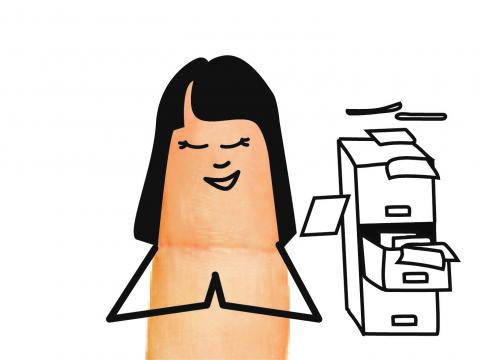Still Using Paper HR Files? Marie Kondo your HR Electronic File Folders or Directories. Fast!

If you're responsible for HR, you probably already have some version of an electronic HR folder or directories structure in place to house your HR files. Or do you?
Admit it. You're still using paper HR files & filing cabinets.
Answer the following honestly. (No one's watching).
- Are you still using filling cabinets and paper HR files?
- Are your employee and independent contractor documents filed in printed form?
If the answer is yes, you already know that you would benefit greatly from digitizing your HR files. Here are just some of the reasons why:
- Electronic files can easily be searched and found. As long as you have the word 'Mohammed', 'Jones', or 'performance review' as part of a document name, you'll get instant access to the file you're looking for.
- You can access your files from anywhere.
- You can't really misfile a document. It won't appear in the dump or in filing cabinet #14 instead of #22. It can't be left behind on the photocopier or forgotten in your briefcase.
- It's much easier for a paper document to get into the wrong hands than one that is stored in your electronic HR folder or directory.
- Sidebar 1: I once had a client who was preparing for an audit and took all their employee files home in a box. The box was inadvertently left in the trunk of their car for a brief time and you guessed it, their car was broken into and the box was taken. The privacy issues in that situation were complex and made for an interesting communication strategy to employees.
- Sidebar 2: (Admittedly more of a rant) Why do I still see thousands of color-coded patient file folders taking up 1/3 of my doctor's office space? Is that safer than digital files? Or why does CRA continue to mail me paper statements and communication instead an instant email to alert me to login? It's shocking how many times my Notice of Assessment ended up in the hands of a neighbor. The reason cited by CRA for the continuation of snail mail as their preferred communication vehicle, is to protect my privacy. Nice.
(Rant off).
- It's cost effective. Your office space no longer needs space for filing cabinets, and your storage no longer needs to include dozens of boxes filled with paper. You also don't have to pay for labor to archive paper files, retrieve them for auditors, and pay for disposing of them safely.
- Paper leaves behind an enormous environmental foot print in its manufacturing and delivery processes, as well as its use of ink and well, trees. Then consider the footprint related to the destruction of documents when they reach retirement.
- There's also those nasty little paper cuts. They're small, but grown men have been known to use them as an excuse to postpone taking out the garbage. (You know who you are).
In the spirit of all this organization and efficiency that comes from going paperless, let's talk about the KonMari Method. It's a popular movement brought to us by the lovely Marie Kondo that helps people tidy and organize thier lives. Kondo's basic principle for sorting papers is to throw them all away. So we took a page out of her book, the life changing magic of tidying up (a metaphorical page of course, we're trying to limit paper here after all) and put an HR spin to it, creating an electronic HR file directory so you can have a paperless office.
We'll follow up on this post and provide an article soon on how to digitize your documents. For now, this post is about setting up your electronic HR folders and directories.
Download a pre-assembled directory of electronic HR folders & sub-folders.
Once you've signed up for ConnectsUs HR, you get access to an instant download of a zip file that contains a pre-assembled file folder tree. It provides empty electronic HR folders and sub-folders structure used to organize your HR forms.
Existing customers can login and download the zip file here and save it to an appropriate directory in your company, and done! Instant HR directories! You can start working with the HR folder structure right away and start saving HR forms in them.
Here's a preview, but we can't show you all of it...
HR Folders
Click image to view full size
You’ll notice some of the folders are numbered. This is so they sort in logical order instead of alphabetically.
Why use 'our' electronic HR folder structure?
You don’t have to use the ConnectsUs HR folder structure, but here are 4 reasons why you might want to:
- Do it right the first time: We’ve put a lot of thought and planning into how to keep the ConnectsUs HR System simple, yet effective. If you don’t use this folder structure, you’ll probably run into some of the same problems we did when we were designing the system, and end up having to re-do work.
- Set the right access permissions: Some of the ConnectsUs templates you customize will contain sensitive and/or confidential content once you begin to use them. You’ll want to restrict access – and our folder structure includes recommended access permissions that are easily configured by your IT people.
- It makes our instructions easier to follow: If you want point-&-Click HR, all ConnectsUs HR Kits assume you have this folder structure in place and instruct you on where to store each file. No additional planning or thinking required.
- Don't re-invent the wheel: We’ve had 30+ years of experience setting up HR systems – first for our employers, and then for our clients. We’ve figured out what works best for us and wanted to share it with you.
You're an Early Majority Adopter
If you're part of the Early Majority in terms of the adoption of electronic HR folders or directories, maybe your current system works well for you, or maybe it doesn’t. However, odds are that your current electronic HR folder structure is beginning to experience some pitfalls. Here are some things to consider:
- Are your WIP (work in progress) files living with your published files?
- Do you have a system in place for file version control?
- Are you currently or will you be sharing HR files with others in your small business?
- If you were to leave the company, could others easily understand your electronic HR folder structure and easily find what they're looking for?
- As you expand your HR breadth in your small business, will your filing system keep up?
Final Word
If you're looking for some mindfullness and organization, the KonMari Method seems like a pretty good place to start. And we've already started the process for you (which is really the hardest part).
Remember that even if you rely on the 'search functionality' to find your files, nothing beats a well-organized directory of HR folders and sub-folders. You can't search for something if you don't know that it exists. Filing your documents in a location that intuitively makes sense means that you can see all related files in one view. We're often pleasantly surprised to find that we've already created a document that we were going to start from scratch.
Which always sparks joy.

Ariane Laird is CEO & Founder of ConnectsUs HR. Contact her directly from the Inquiry Type drop down menu.


